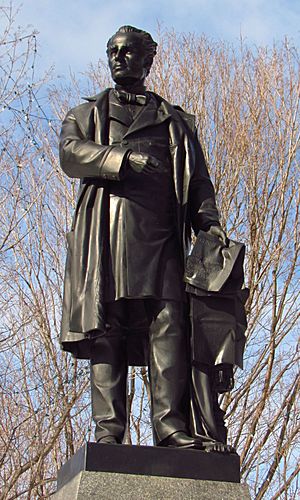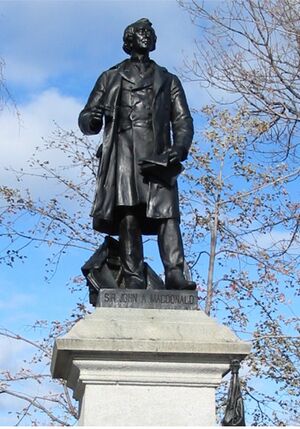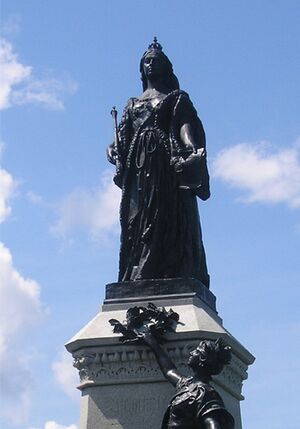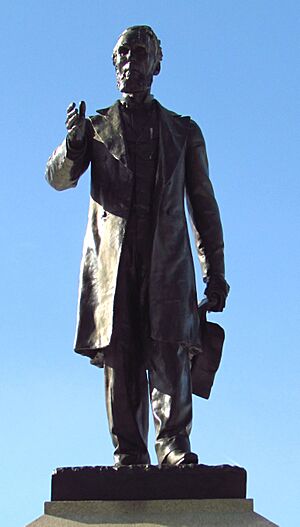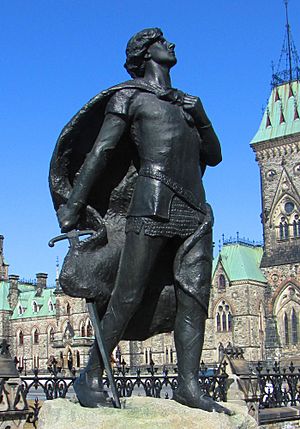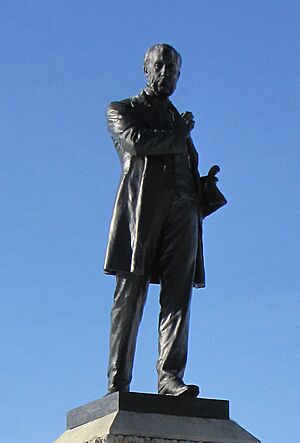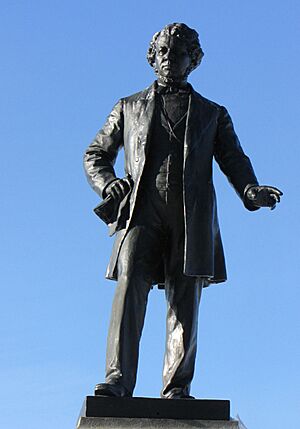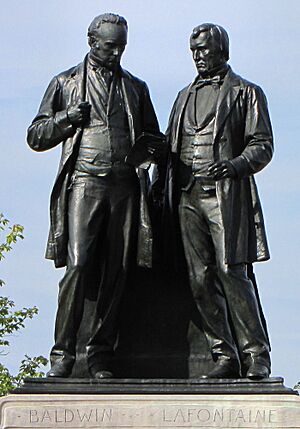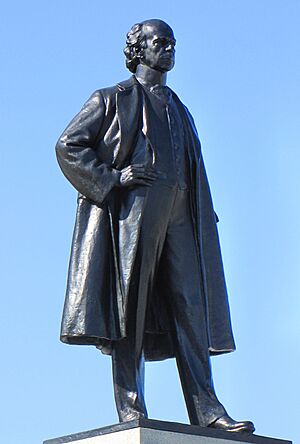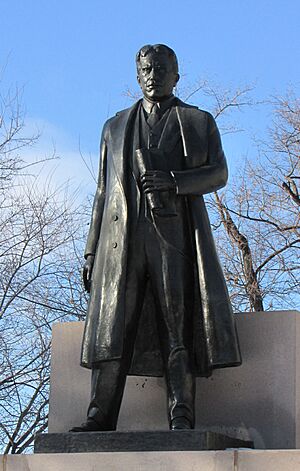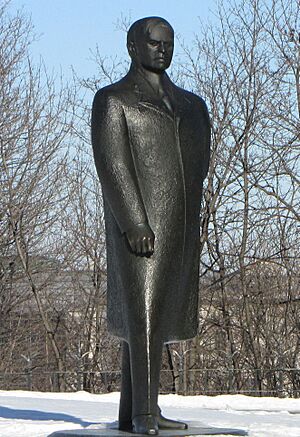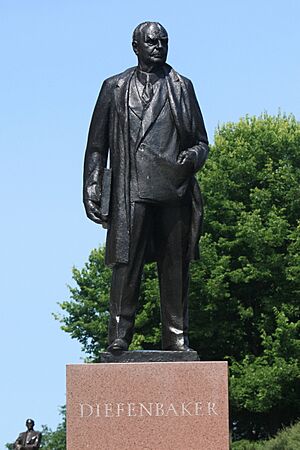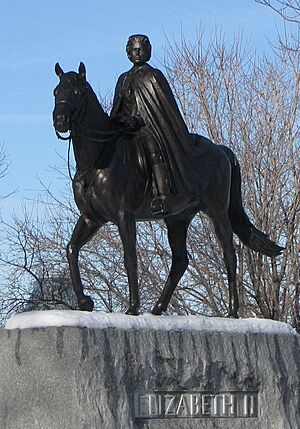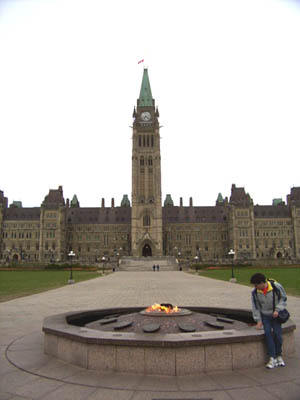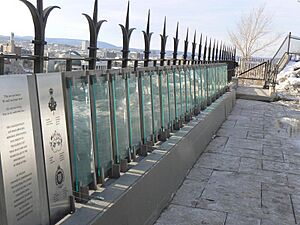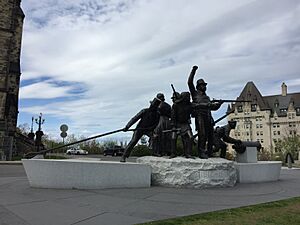Parliament Hill facts for kids
Quick facts for kids Parliament HillColline du Parlement |
|
|---|---|
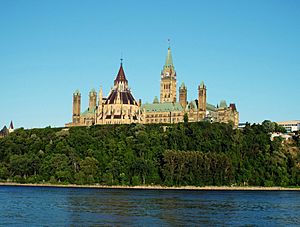
Parliament Hill, as viewed from Gatineau at sunset on a July 2014 summer's day
|
|
| Location | Ottawa River / Wellington Street, Downtown Ottawa, Canada |
| Built | 1859–1927 |
| Built for | Legislature of the Province of Canada, Parliament of Canada |
| Architect | Calvert Vaux, Marshall Wood (landscapes) Thomas Scott (oversight) |
| Visitors | 3 million annually |
| Governing body | National Capital Commission |
| Official name: Parliament Buildings National Historic Site of Canada | |
| Designated: | 1976 |
| Official name: Grounds of the Parliament Buildings National Historic Site of Canada | |
| Designated: | 1976 |
Parliament Hill (also known as French: Colline du Parlement) is a special place in Ottawa, Ontario. Ottawa is the capital city of Canada. Parliament Hill is where the Government of Canada works and where Members of Parliament (MPs) make important laws for the country. It's called Parliament Hill because it sits on a hill overlooking the beautiful Ottawa River.
There are three main buildings on Parliament Hill: the West Block, the East Block, and the Centre Block. These buildings are very old and have a lot of history.
In 1916, a big fire destroyed the Centre Block. Luckily, the library building was saved from the flames. The Centre Block was rebuilt, and the famous Peace Tower was finished in 1927.
The roof of each building is made of copper. Over time, this copper turns a unique green color.
Around Parliament Hill, you can see many statues. These include statues of former Prime Ministers and five famous women who fought for equal rights in Canada. There is also a special Centennial Flame that was lit when Canada turned 100 years old.
Contents
- Statues and Monuments on Parliament Hill
- Who are the Famous People Honored?
- Sir George-Étienne Cartier
- Sir John A. Macdonald
- Queen Victoria
- Alexander Mackenzie
- Sir Galahad
- George Brown
- D'Arcy McGee
- Robert Baldwin and Sir Louis-Hippolyte Lafontaine
- Sir Wilfrid Laurier
- Sir Robert Borden
- William Lyon Mackenzie King
- John Diefenbaker
- Lester B. Pearson
- Queen Elizabeth II
- The Famous Five
- Other Important Monuments
- Who are the Famous People Honored?
- Images for kids
- See also
Statues and Monuments on Parliament Hill
Parliament Hill is home to many statues and monuments. Most of these are located behind the three main Parliament buildings. They honor important people and events in Canadian history.
Who are the Famous People Honored?
Many statues on Parliament Hill celebrate important figures from Canada's past. These include former Prime Ministers and even a Queen.
Sir George-Étienne Cartier
This was the very first statue placed on Parliament Hill. It honors Sir George-Étienne Cartier, a key figure in Canada's history. The statue was created by Louis-Philippe Hébert in the 1880s.
Sir John A. Macdonald
Sir John A. Macdonald was Canada's first Prime Minister. His statue was also sculpted by Louis-Philippe Hébert. It was unveiled in the 1880s at the southeast corner of the Centre Block.
Queen Victoria
A statue of Queen Victoria, Canada's first monarch, stands between the West and Centre Blocks. Louis-Philippe Hébert sculpted this statue in 1900. It was officially dedicated in 1901.
Alexander Mackenzie
Alexander Mackenzie was another important Canadian politician. His statue, also by Louis-Philippe Hébert, was unveiled in 1901.
Sir Galahad
This is a unique statue on Parliament Hill because it's not of a politician or monarch. It honors Henry Albert Harper, a friend of future Prime Minister William Lyon Mackenzie King. The statue was installed in 1905 and created by Ernest Wise Keyser.
George Brown
The statue of George Brown was created by George William Hill. It was put up in 1913.
D'Arcy McGee
Thomas D'Arcy McGee's statue was also sculpted by George William Hill. It was unveiled in 1913.
Robert Baldwin and Sir Louis-Hippolyte Lafontaine
This special dual statue features Robert Baldwin and Sir Louis-Hippolyte Lafontaine. It was created by Walter Seymour Allward and has been on Parliament Hill since 1914.
Sir Wilfrid Laurier
Sir Wilfrid Laurier was a well-known Prime Minister. His statue, created by Joseph-Émile Brunet, was placed at the southeast corner of the site in 1922.
Sir Robert Borden
Frances Loring sculpted this statue of Sir Robert Borden. It was unveiled in 1957 and stands at the southwest corner of Parliament Hill.
William Lyon Mackenzie King
This statue of William Lyon Mackenzie King was made for the Canadian Centennial in 1967. It was designed by Raoul Hunter and is located at the northwest corner of the East Block.
John Diefenbaker
John Diefenbaker's statue was sculpted by Leo Mol and completed in 1985. It stands just north of the West Block.
Lester B. Pearson
In 1989, Danek Mozdzenski was asked to create this monument for Lester B. Pearson. It is located north of the West Block.
Queen Elizabeth II
A statue of Queen Elizabeth II was sculpted by Jack Harman. It was unveiled in 1992 as part of Canada's 125th anniversary celebrations.
The Famous Five
This monument celebrates The Famous Five, a group of five women who fought for women's rights. The monument includes statues of Emily Murphy, Irene Parlby, Nellie McClung, Louise McKinney, and Henrietta Edwards, plus an empty chair. It was created by Barbara Paterson and donated in 2000.
Other Important Monuments
Besides statues of people, Parliament Hill also has other monuments that remember important historical moments or groups of people.
Centennial Flame
The Centennial Flame is a fountain with a flame that burns continuously. It was dedicated on January 1, 1967, by Lester B. Pearson to mark the start of the Canadian Centennial.
Canadian Police Memorial
This memorial honors Canadian police officers who have died while doing their duty since 1879. It was dedicated in 1994 and has been expanded to include names from all law enforcement agencies.
Victoria Tower Bell
Unveiled in 2000, this bell is the original one from the Victoria Tower. It fell during the 1916 fire, and the monument shows it tilted, just as it was found.
War of 1812 Monument
This monument represents the War of 1812. It features seven figures, including a First Nations person, a British soldier, and a woman. It also has a maple tree planted with soil from Canadian battlefield sites. It was dedicated on November 6, 2014.
Images for kids
-
The Ottawa locks of the Rideau Canal, with Barrack Hill—present-day Parliament Hill—right of centre; 1832
-
Troops deliver a feu de joie on Parliament Hill for the Queen's Birthday Review in 1868.
-
The Office of the Prime Minister and Privy Council Building is one of several federal properties situated next to Parliament Hill
See also
 In Spanish: Parliament Hill para niños
In Spanish: Parliament Hill para niños


